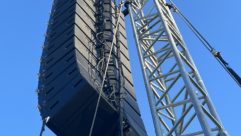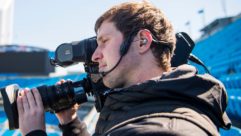Unsafe Levels
Jul 1, 2001 12:00 PM,
By Rachel Cruz & Dilys Jones
The idea that you’re responsible for the health and safety of your own ears is common sense. That you may be responsible for somebody else’s is now being discussed…
ALL SOUND PROFESSIONALS SHOULD educate themselves about hearing loss and hearing conservation. Despite their expert understanding of acoustics — and often psychoacoustics — many audio professionals misinterpret or misunderstand information about general ear physiology. Misunderstanding these issues may result in inadvertent overexposure to loud sounds by professionals or a sound system’s audience.
To some extent, the success of your business relies on your subjective ability to perceive acoustical flaws or sweet spots in a space. Hearing loss is correlated with decreased psychological health, higher stress and anxiety levels and, sometimes, more serious health problems.
Over the past few years, some bands, management companies, venues and audio engineers have had highly publicized lawsuits brought against them by audience members alleging hearing loss as the result of attending particular concerts. In the live-sound arena, out-of-court settlements have added up to imposing sums. Complaints have also been registered at movie theaters as new technology has improved the performance of sound systems and increased the volume of sound effects and scores. This means that members of the pro-audio industry and their consumers are becoming targets for litigation. Liability issues are becoming a concern as failures to understand and disclose potential sound hazards to a client may put staff, venue employees and the public at risk. Hearing conservation should always be a serious consideration for anyone who is responsible for instruction, installation or use of an audio system.
WHAT’S INVOLVED?
When an employee files a worker’s compensation claim, the business owner’s insurance company reviews the claim, and a settlement may be agreed upon. If a claim is disputed, the business owner and the employee may retain legal services in the case. A qualified medical examiner reviews the case history and presents a report to a worker’s compensation judge. An award may amount to $20,000 or more based on earnings lost, length of employ, future medical expenses and state codes. Legal fees, increased insurance rates and copycat claims may add to the overall cost.
WHO’S RESPONSIBLE?
It is increasingly important for the professional responsible for the successful installation and testing of sound systems to examine the hearing safety guidelines set by the Occupational Safety and Health Administration. OSHA clearly defines the amount of time that one can safely be exposed to particular sound levels. Based on a time-weighted average of noise exposure over an 8-hour period, OSHA recommends enacting a hearing conservation program whenever sound levels exceed 85 dBA for extended periods of time. At sound levels over 90 dBA, the law mandates the use of hearing protection and a reduction of noise exposure.
According to the National Institute on Deafness and other Communication Disorders, regular exposure to sound levels of 110 dB for more than one minute poses the risk of permanent hearing loss. At 100 dB, no more than 15 minutes of unprotected exposure is recommended. Both the National Institute for Occupational Safety and Health and OSHA have developed standards for permissible sound level exposure in the workplace. While the OSHA guidelines are more widely known, hearing health professionals often cite them as being somewhat liberal. The NIOSH guidelines are more conservative. Both organizations use a tradeoff rule: For each increase in sound power, the duration of acceptable exposure is halved.
To guard against possible litigation from employees, contractors should implement hearing conservation programs following these guidelines. The ideal program includes baseline hearing tests for all employees and new hires. Incorporate an annual hearing exam into your healthcare benefits and give employees ready access to hearing protection devices. For an effective program, all elements must be attentively managed, which means educating employees and making sure they comply with the hearing safety protocols. As an additional precaution, educate clients on safety guidelines and suggest they take similar steps to avert litigation.
The idea that you’re responsible for the health and safety of your ears is common sense. The idea that you may be responsible for somebody else’s hearing health is now being discussed among sound contractors. The music, film and theme park industries do not fall neatly into career categories where overexposure to loud sound is legally monitored or regulated. The issue under debate in the pro-audio industry is whether we should carefully monitor and regulate our own sound levels before that right is taken away from us in the courtroom.
HEARING 101
The healthy ear is a sophisticated system of acoustical, mechanical, chemical, hydraulic and electrical engineering. It involves the passage of a signal through the ear canal, where sound energy is given a boost between 1.5 and 2.7 kHz due to the natural resonance of the canal. It is then mechanically transduced through the action of an efficient impedance transformer — the middle ear. Most of the sound entering the middle ear is passed on into the fluid-filled space of the cochlea, or the inner ear. The cochlea, the sensory mechanism for hearing, is essentially a real-time frequency analyzer. Intensity and timing or phasic (directional) differences of a sound source also begin their processing here.
Not only does the hearing system receive sound information from the environment; it also sends it to the brain, where highly complex bioelectric processes allow the listener to associate sounds with meaning, emotions and other complex cognitive processes. Interestingly, after sound information reaches the brain, it travels back to the ear. This efferent auditory system, while not well understood, is thought to be responsible for the high degree of frequency specificity with which we can hear.
If there is any damage to sensory cells in the inner ear, there will be a loss of frequency selectivity in the cochlea. Damage in the cochlea means that the ear’s dynamic range is also reduced. After hearing loss has occurred, the brain becomes starved for the auditory information it was accustomed to receiving. Once the sensory cells in the cochlea are damaged, the loss of those cells begins a chain reaction of cell death. Supporting cells in the cochlea are destroyed, as are the neural connections from the cochlea to the brain. This loss can occur over the course of several years. Therefore, even audio professionals’ ears may not immediately notice the perceptual changes taking place. Almost always, hearing loss from overexposure to loud sounds will first result in a loss of the ability to hear high frequencies and, later, middle and low frequencies.
EFFECTS OF HEARING LOSS
Not always discussed, but of equal importance to many professional listeners, are the functional effects of hearing loss as well as preventative measures one can take to maintain hearing health. Most people begin to realize a change in their hearing ability during day-to-day activities. They may struggle to understand a conversation in a noisy environment, or even in a quiet room with more subtle background noise. In more extreme cases, people may notice timbral changes in music. They may find themselves increasing the volume on the stereo or television. The problem is that some people suffering from hearing loss need more than an increase in volume. They need more clarity of sound.
Audiologists can fit a person with a hearing aid to amplify sound, but not to clarify or distinguish sound. In order to improve hearing-aid performance under noisy conditions, scientists at the House Ear Institute have focused their research on binaural hearing. Sigfrid Soli, Ph.D., and Michael Nilsson, Ph.D., have found that the binaural system uses the time and level differences of sound as it arrives at the left and right ears to improve hearing in noise. They applied this knowledge to develop the normalized Hearing in Noise Test (HINT) in order to measure the functional ability to hear in noisy conditions.
“The results of our tests showed that some people, who generally demonstrated normal hearing thresholds in a clinical test, may show a handicap in the binaural/directional HINT — especially if they have a mild to moderate high-frequency hearing loss,” said Dr. Soli. These results demonstrate how the HINT can be used to screen sound professionals and others in hearing-critical jobs. Sound professionals need to detect, recognize and distinguish sounds that occur in the presence of background noise.
By testing hundreds of people, House Ear Institute scientists found that normal pure tone sensitivity did not necessarily indicate normal functional ability. That is, clinical hearing test results may differ from those that test for ability to function in daily life. Consequently, hearing is being evaluated in new ways, especially for hearing-sensitive occupations. This may lead ear specialists to redefine the measures associated with hearing loss for disability purposes. This new direction of thought is important because hearing specialists will be able to maximize the benefits for users of prosthetic devices and apply this knowledge to hearing aid research.
Rachel Cruz is an audio engineer and licensed audiologist currently doing research on music perception. Dilys Jones is House Ear Institute’s marketing/communications director. She develops and administers the Sound Partners program. Contact them at[email protected], and find more information atwww.hei.org.
Advances in Audio Testing
Two organizations recently made donations to the HEI’s Sound Partners program, enabling audiologists to offer hearing tests to audio professionals in Los Angeles. Sennheiser Electronic Corporation donated two pairs of closed dynamic HAD 200 Audiometric headphones. The Western Lion’s Ear Foundation donated funds for the purchase of a 2-channel audiometer that measures hearing thresholds up to 16 kHz. The House Ear Clinic will use this equipment to conduct EHF tests as part of a pilot study and gather data from the clinic’s test results to establish clinical norms and improve testing methods.
Some audiologists are now performing a diagnostic test called otoacoustic emissions. A healthy cochlea not only receives energy, but also emits a small amount of energy. As sensory cells in the cochlea are damaged, the cochlea will emit less energy at various frequencies. This objective test reveals information about cochlear health. Typically, a loss of sensory cells in the cochlea will be seen as a loss of OAEs prior to a subjectively perceived hearing loss in pure tone thresholds. Often, this is a warning sign to reassess daily sound exposure.
Managing Your Hearing Health
The initial point of entry into a hearing health program is usually through an audiologist, who will test the health of the entire hearing system. You should find an audiologist able to perform extended high-frequency (EHF) testing or high-frequency audiometry, pure-tone threshold testing from 12 to 16 kHz or higher.
If a medical problem regarding your ears presents itself during your audiologic evaluation, you would be referred to an otologist or otolaryngologist. While the audiologist is typically an expert in the area of diagnostic testing and rehabilitation, the otologist is responsible for the medical, pharmacological or surgical management of a hearing problem. Annual audiometric exams and good communication with your audiologist are the best steps to conserve hearing.










